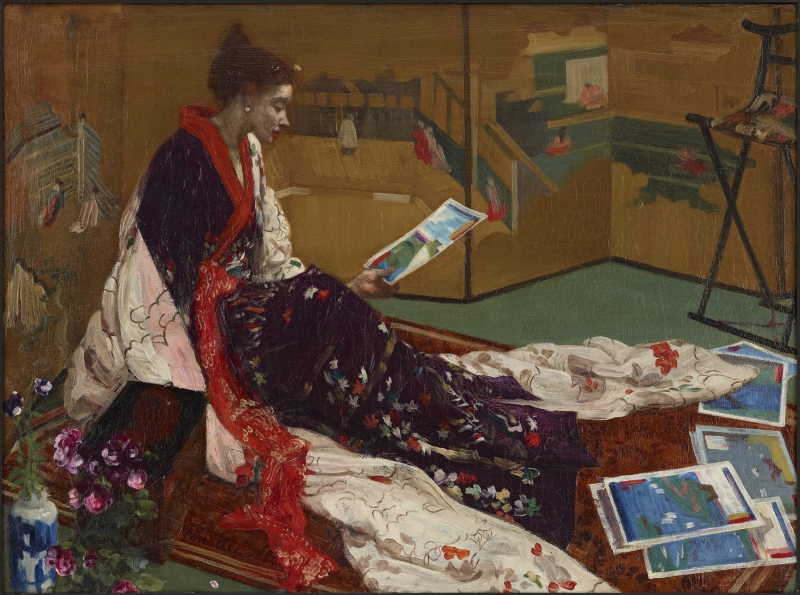Home > Catalogue > People > Dante Gabriel Rossetti (related works) > Catalogue entry
Titles
Several possible titles have been suggested:
- 'The golden screen' (1865, Royal Academy of Arts). 1
- 'The Golden Screen – Harmony in purple and gold (No. 2)' (1873, Society of French Artists). 2
- 'Golden Screen' (1878, Whistler). 3
- Possibly 'Harmony & [sic] Purple & gold' (1881, Whistler). 4
- Possibly 'Harmony in purple & gold' (1892, Whistler). 5
- 'Gold Screen' (1892, Whistler). 6
- 'Caprice in Purple and Gold: The Golden Screen' (1892, Goupil). 7
- 'Caprice en pourpre et or. – L'Ecran doré. – (Caprice in Purple and Gold. The Gold Screen)' (1905, Palais de l'Ecole des Beaux-Arts, Paris). 8
- 'Caprice in Purple and Gold: The Golden Screen' (1980, YMSM). 9
When it was exhibited in 1873, it was called 'The Golden Screen: Harmony in purple and gold (No. 2)', but before that date there is no record of a painting called 'Harmony in purple and gold No. 1', unless Purple and Rose: The Lange Leizen of the Six Marks [YMSM 047] was first thought of as 'Purple and Gold' before being called 'Purple and Rose'. However, the title given in the 1873 exhibition catalogue (in which Whistler showed two paintings) could have been a mistake by the gallery. A label in Whistler's hand on the back of Caprice in Purple and Gold: The Golden Screen [YMSM 060] reads: 'No. 2: The Golden Screen (oil painting)'.
'Caprice in Purple and Gold: The Golden Screen', as it was entitled in 1892, is the definitive title.
Description
A composition in horizontal format, showing a woman in a black embroidered kimono and red patterned scarf sitting on the floor, in profile to right. A white embroidered stole is also draped around her, spreading out onto the floor in the foreground. She holds a colour woodcut in her hands and several other Japanese prints are scattered on the floor around her. At right, behind the prints, is a folding chair, and behind her, right across the background, a gold painted screen. In the foreground at left is a blue and white Chinese jar.
Charles Lang Freer (1856-1919) thought that the screen was of the Tosa school. 10 The screen is not specifically identifiable but, according to the Freer Gallery of Art, the subject appears to be of the literary type, such as the Tales of Genji. 11
The model is looking at the prints of Ando Hiroshige (1797-1858), as discussed by MacDonald :
'These included Hiroshige’s 1855 colour woodcut Saijo, Iyo Province from Views of Famous Places in the 60-odd Provinces. A richly coloured, bold design, with startling perspective, it is dominated by the fan-shaped curve of a single sail, gathered into the mast like the waist of a robe. In the distance is a mountain, and tiny boats in the bay. Perhaps this provided inspiration for paintings such as Grey and Silver – Old Battersea Reach, where the sails dominate the composition.' 12
Other prints shown may be Hiroshige’s Osumi Province: Sakura shima (Ôsumi, Sakura shima), Suruga Province: Miho Pine Grove (Suruga, Miho no matsubara), and Etchu Province: Toyama, Pontoon Bridge (Etchu, Toyama funabashi) from the series Famous Places in the Sixty-odd Provinces (Rokujuyoshu meisho zue), published in 1853. 13
Sitter
Joanna Hiffernan (b. ca 1843-d.1886) , who also posed in Asian dress for Purple and Rose: The Lange Leizen of the Six Marks [YMSM 047].
Notes:
1: 97th Exhibition of the Royal Academy of Arts, London, 1865 (cat. no. 90).
2: Sixth Exhibition of the Society of French Artists [Summer Exhibition], Deschamps Gallery, London, 1873 (cat. no. 109).
3: Whistler to J. A. Rose, [November 1878], GUW #08784.
4: Note by Whistler on letter from H. Faraday to T. Way, 12 March 1881, GUW #13354.
5: Whistler to D. C. Thomson, [4/11 January 1892], GUW #06795.
6: Whistler to D. C. Thomson, 21 February [1892], GUW #08212.
7: Nocturnes, Marines & Chevalet Pieces, Goupil Gallery, London, 1892 (cat. no. 14).
8: Œuvres de James McNeill Whistler, Palais de l'Ecole des Beaux-Arts, Paris, 1905 (cat. no. 8).
9: YMSM 1980 [more] (cat. no. 60).
10: Freer to R. Birnie Philip, 1l August 1904, GUL MS Whistler BP III 4/60.
11: Note by A. Yonaumara, curator of the Oriental collections, Freer Gallery of Art.
12: V&A E367-1896; MacDonald 2013 [more] , at p. 23.
13: See MacDonald, Margaret F., 'Joanna Hiffernan and James Whistler: an Artistic Partnership' in Margaret F. MacDonald (ed.), The Woman in White: Joanna Hiffernan and James McNeill Whistler, New Haven and Washington, 2020, pp. 15-31.
Last updated: 11th October 2021 by Margaret








